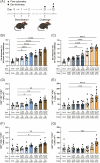Cross-reactivity between thiuram disulfides and dithiocarbamates. A study of TETD and ZDEC using mouse models
- PMID: 39340203
- PMCID: PMC11710922
- DOI: 10.1111/cod.14706
Cross-reactivity between thiuram disulfides and dithiocarbamates. A study of TETD and ZDEC using mouse models
Abstract
Background: Rubber accelerators are used in the vulcanization of rubber. However, rubber accelerators for example tetraethylthiuram disulfide (TETD) and zinc diethyldithiocarbamate (ZDEC) may cause contact allergy. Concomitant reactions between ZDEC and TETD have been observed in patients which could be explained by co- or cross-reactivity.
Objectives: To investigate cross-reactivity between TETD and ZDEC and vice versa.
Methods: Groups of mice were sensitized with TETD or ZDEC based on reported EC3-values. Proliferation of lymphocytes were measured on day 5. To test cross-reactivity, mice were sensitized and challenged 3 weeks later with TETD or ZDEC. The inflammatory response was measured by changes in ear thickness and the proliferative response in CD4+ and CD8+ T cells in the submandibular and cervical draining lymph nodes.
Results: Sensitization of mice with doses of ZDEC 3%, TETD 5.6% or TETD 16.2% induced significant increased ear thickness and proliferation of CD4+ and CD8+ T cells. Challenge with ZDEC or TETD in these groups induced significant increased ear thickness. Challenge with ZDEC in mice sensitized to TETD 5.6% or TETD 16.2% induced significant increased proliferation of CD4+ and CD8+ T cells.
Conclusions: We show cross-reactivity between TETD and ZDEC. Patients sensitized to TETD or ZDEC should avoid exposure to both ZDEC and TETD.
Keywords: TETD; ZDEC; allergic contact dermatitis; contact allergy; contact dermatitis; dermatitis; dithiocarbamates; immunology; rubber accelerators; thiurams.
© 2024 The Author(s). Contact Dermatitis published by John Wiley & Sons Ltd.
Conflict of interest statement
The authors declare no conflicts of interest.
Figures



References
MeSH terms
Substances
Grants and funding
LinkOut - more resources
Full Text Sources
Research Materials

